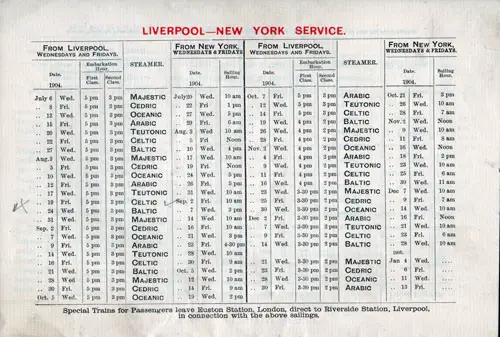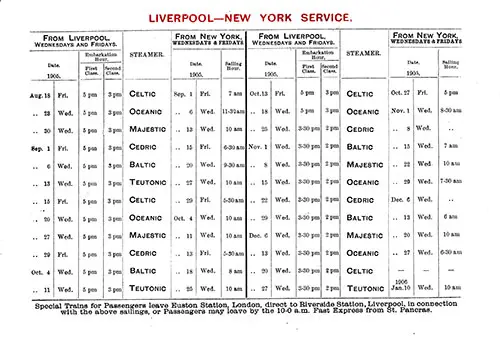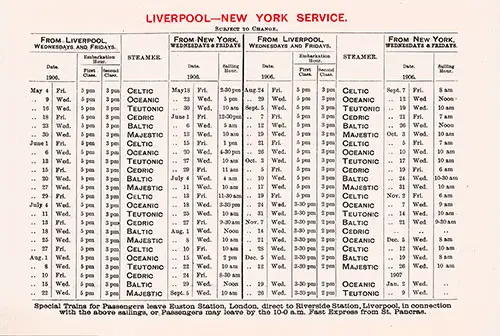RMS Teutonic Archival Collection
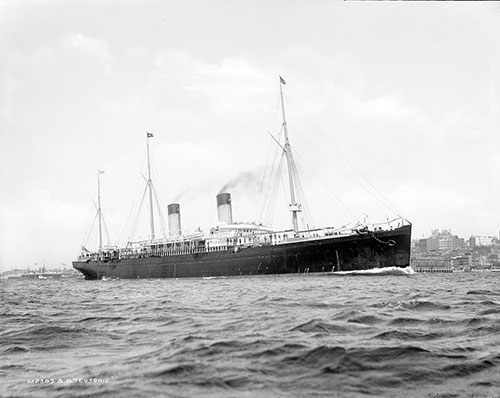
The RMS Teutonic of the White Star Line, c1890. | GGA Image ID # 1ed3590bc7
Content Links
- Teutonic (1889) White Star Line Ship's History (Brief)
- Passenger Lists
- Brochures
- Route Maps, Track Charts, Abstract of Logs
- Sailing Schedules
- Photographs
- Services
- Advertisements
- Excerpts from Information for Passengers
- Other Ephemera
- Books Referencing the RMS Teutonic
- Teutonic - 1889 - Ship Information and History
Teutonic (1889) White Star Line
Built by Harland & Wolff, Ltd., Belfast, Ireland. Tonnage: 9,686. Dimensions: 565' x 57' (582' o.l.). Propulsion: Twin-screw, 20 knots. Triple expansion engines. 19,500 I.H.P. Masts and Funnels: Three masts and two funnels. Steel hull. Displacement of 16,740 tons. She had 16 boilers, 76 furnaces. Consumed 12 tons of coal per hour to obtain a speed of 20 knots. Passengers: 300 first, 190 second, 1,000 third. Speed Records: She won the coveted Blue Ribbon by beating all previous records by steaming from Queenstown to Sandy Hook in 5 days, 16 hours and 31 minutes, thus averaging 20.43 knots for the trip. Fate: Sold to Dutch ship-breakers in July 1921, but resold to Germany for scrap in September 1921. Sister ship: Majestic. Note: These liners were built at a cost of $2,000,000 each. (In 2022, the relative values of $2,000,000.00 from 1889 ranges from $60,000,000.00 to $3,640,000,000.00.)
Return to Content Links
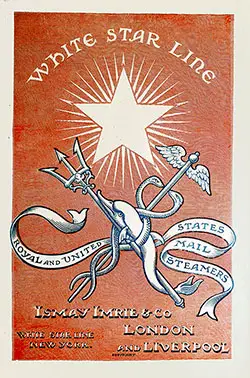
1898-05-18 SS Teutonic Passenger List
Steamship Line: White Star Line
Class of Passengers: Saloon
Date of Departure: 18 May 1898
Route: Liverpool to New York
Commander: Captain J. G. Cameron, R.N.R.

1903-02-04 SS Teutonic Passenger List
Steamship Line: White Star Line
Class of Passengers: Saloon
Date of Departure: 4 February 1903
Route: New York to Liverpool
Commander: Captain Edward R. McKinstry
Notable Passengers: John J. Cone, Blair Fairchild, Moses A. Gunst, and Clarence Wayland Watson.

1910-09-14 RMS Teutonic Passenger List
Steamship Line: White Star Line
Class of Passengers: First Class
Date of Departure: 14 September 1910
Route: Southampton and Cherbourg to New York via Queenstown (Cobh)
Commander: Captain R. W. James
Return to Content Links
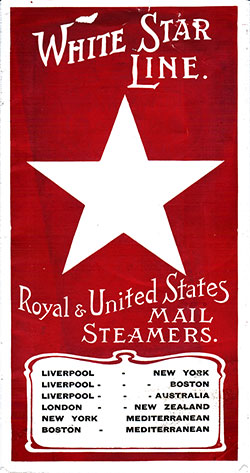
1907 - White Star Line Fleet, History, and Services
Excellent brochure from the White Star Line covering all three classes of services at the height of the transatlantic immigrant trade. Profusely illustrated with many photographs of the ships and accommodations.
Featured Ships: Arabic, Athenic, Baltic, Canopic, Cedric, Celtic, Corinthic, Cretic, Cymric, Ionic, Majestic, Oceanic, Republic, Romanic, Runic, and Teutonic.

The Steamers of the White Star Line - 1909
A 1909 Brochure from the White Star Line is a Pictorial Featuring the Olympic and Titanic, Adriatic, Baltic, Canopic, Celtic, Laurentic and Megantic, Majestic and Teutonic, Romanic, Oceanic, Zeeland, and more.
Return to Content Links
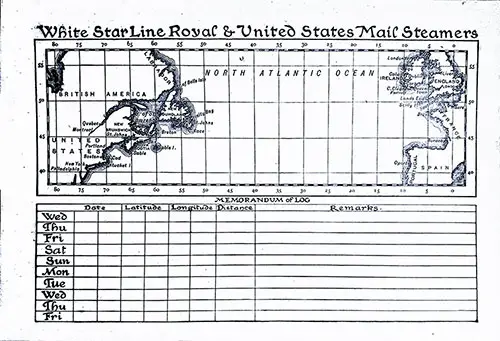
Track Chart and Memorandum of Log (Unused) on the Back Cover, White Star Line SS Teutonic Saloon Passenger List, 18 May 1898. | GGA Image ID # 162f3b7080
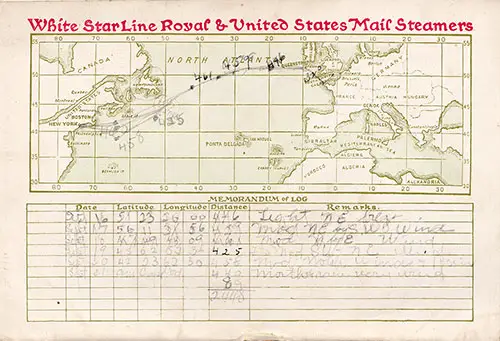
Track Chart and Memorandum of Log, Maintained by Passenger on the 14 September 1910 Voyage of the RMS Teutonic. | GGA Image ID # 1ed0eebb9b
Return to Content Links
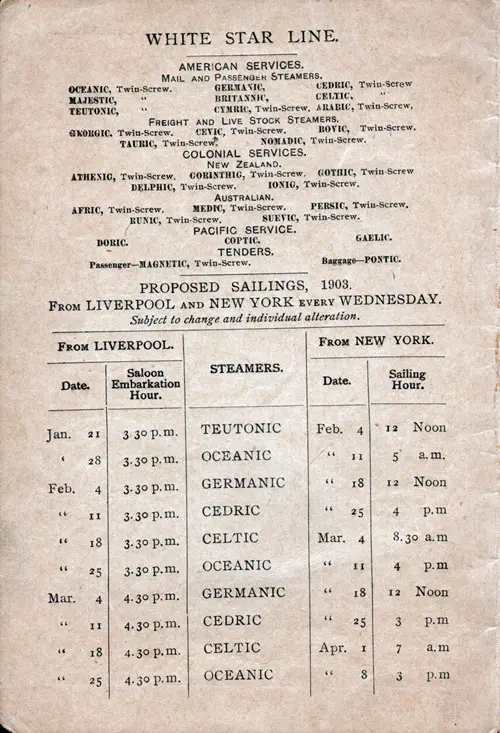
Sailing Schedule, Liverpool-New York, from 21 January 1903 to 8 April 1903. Ships Included the Cedric, Celtic, Germanic, Oceanic, and Teutonic. RMS Teutonic Passenger List, 4 February 1903. | GGA Image ID # 1ed193d786

Sailing Schedule, Liverpool-Queenstown (Cobh)-New York, Liverpool-Queenstown (Cobh)-Boston, and Boston-Mediterranean Service, from 18 June 1904 to 8 October 1904. Ships Included the Arabic, Baltic, Canopic, Cedric, Celtic, Cretic, Cymric, Majestic, Oceanic, Republic, Romanic, and Teutonic. RMS Celtic Passenger List, 19 August 1904. | GGA Image ID # 1e4efde338
Sailing Schedule, Liverpool-New York Service, from 6 July 1904 to 13 January 1905. Ships Included the Arabic, Baltic, Cedric, Celtic, Majestic, Oceanic, and Teutonic. RMS Celtic Passenger List, 19 August 1904. | GGA Image ID # 1e4e8ea9b7. Click to View Larger Image.
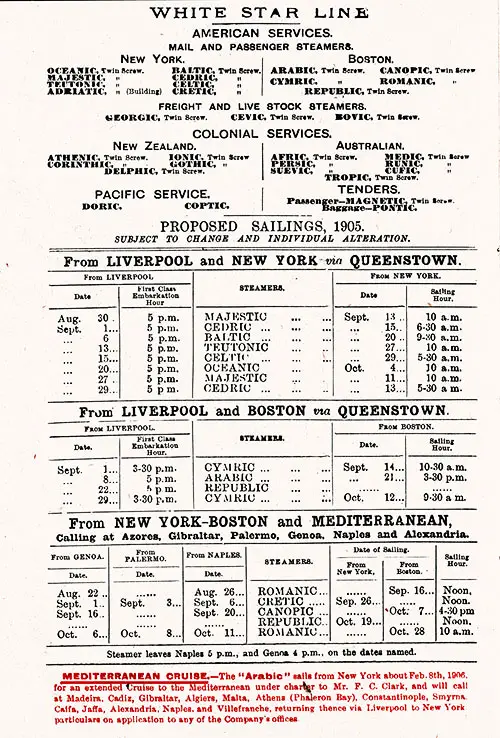
White Star Line American and Colonial Services. Proposed Sailings from 22 August 1905 to 28 October 1905. Ships Include the Arabic, Baltic, Canopic, Cedric, Celtic, Cretic, Cymric, Majestic, Oceanic, Republic, Romanic, and Teutonic. MEDITERRANEAN CRUISE—The "Arabic" sails from New York on Feb. 8th, 1906, for an extended Cruise to the Mediterranean under charter to Mr. F. C. Clark and will call at Madeira, Cadiz, Gibraltar, Algiers, Malta, Athens (Phaleron Bay), Constantinople, Smyrna. Haifa, Jaffa, Alexandria, Naples, and Villefranche, returning thence via Liverpool to New York, particulars on application to any of the Company's offices. RMS Majestic Passenger List, 30 August 1905. | GGA Image ID # 1dd41e606f
White Star Line Liverpool-New York Service from 18 August 1905 to 10 January 1906. Ships Include the Baltic, Cedric, Celtic, Majestic, and Teutonic. Special Trains for Passengers leave Easton Station. London, direct to Riverside Station, Liverpool, in connection with the above sailings, or Passengers may leave by the 10:00 a.m. Fast Express from St. Paneras. RMS Majestic Passenger List, 30 August 1905. | GGA Image ID # 1dd49614e0. Click for Larger Image.
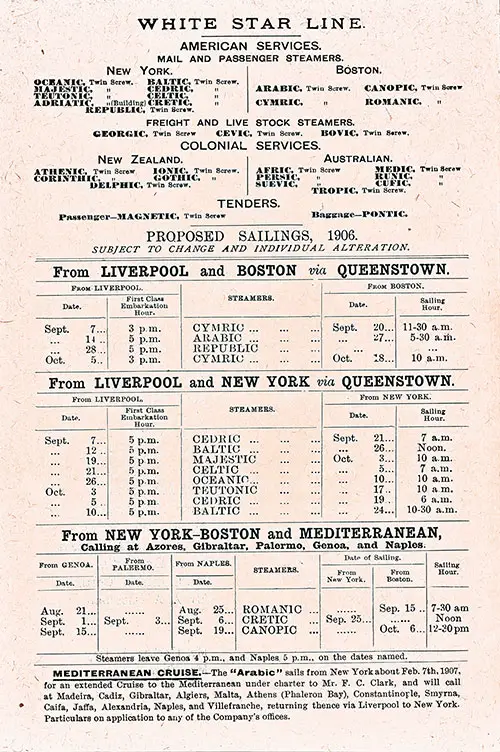
American and Colonial Services, Sailing Schedule, Liverpool-Queenstown (Cobh)-Boston, Liverpool-Queenstown (Cobh)-New York, and New York-Boston-Mediterranean, from 21 August 1906 to 28 October 1906. Ships Included the Arabic, Baltic, Canopic, Cedric, Celtic, Cretic, Cymric, Majestic, Oceanic, Republic, Romanic, and Teutonic. MEDITERRANEAN CRUISE,—The "Arabic" sails from New York about February 7th, 1907, for an extended Cruise to the Mediterranean under charter to Mr. F. C. Clark, and will call at Madeira, Cadiz, Gibraltar, Algiers, Malta, Athens (Phaleron Bay), Constantinople, Smyrna, Caifa, Jaffa, Alexandria, Naples, and Villefranche, returning thence via Liverpool to New York. RMS Cymric Passenger List, 7 September 1906. | GGA Image ID # 1e550c39be
Sailing Schedule, Liverpool-New York Service, from 4 May 1906 to 9 January 1907. Ships Included the Baltic, Cedric, Celtic, Majestic, Oceanic, and Teutonic. RMS Cymric Passenger List, 7 September 1906. | GGA Image ID # 1e55bda7dd. Click to View Larger Image.
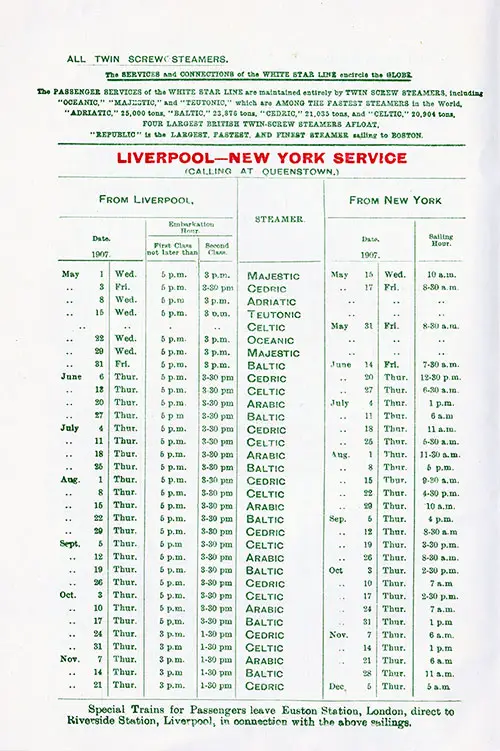
Sailing Schedule, Liverpool-New York Service, from 1 May 1907 to 6 December 1907. Ships Included the Adriatic, Arabic, Baltic, Cedric, Celtic, Majestic, Oceanic, and Teutonic. RMS Republic Passenger List, 14 August 1907. | GGA Image ID # 1e58351d4c
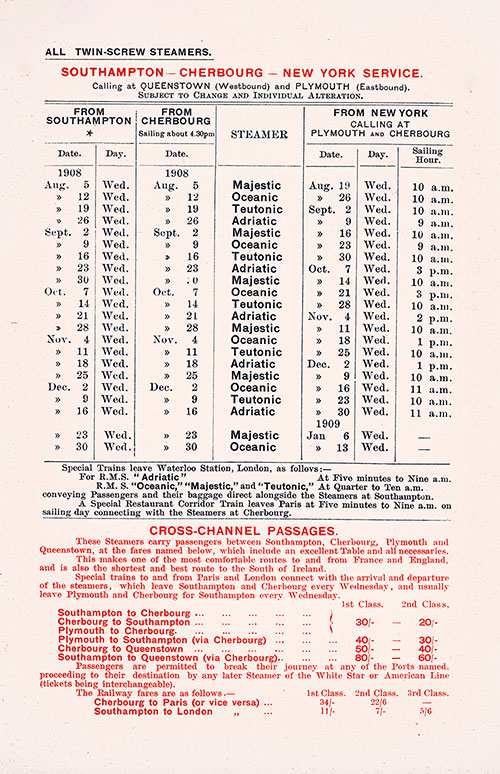
Sailing Schedule, Southampton-Cherbourg-New York Service, from 5 August 1908 to 13 January 1909. Ships Included the Adriatic, Majestic, Oceanic, and Teutonic. Information and Fares for Cross-Channel Passages is also Listed. SS Romanic Passenger List, 4 October 1908. | GGA Image ID # 1e57207633
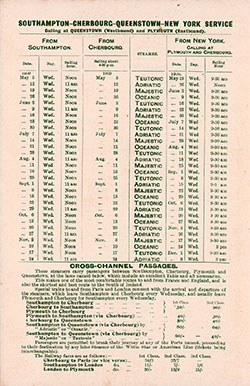
White Star Line Sailing Schedule, 5 May 1909 to 8 December 1909
The RMS Teutonic, operated by the White Star Line, was scheduled for transatlantic voyages between 5 May 1909 to 8 December 1909.
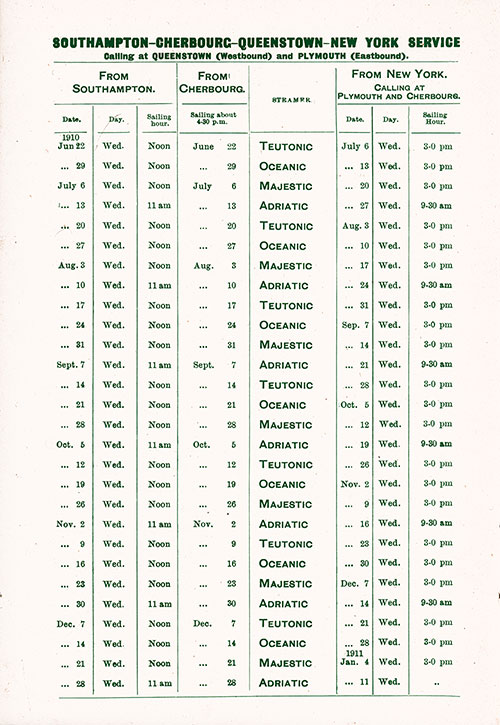
Sailing Schedule, Southampton-Cherbourg-Queenstown (Cobh)-New York Service, from 22 June 1910 to 11 January 1911. Ships Included the Adriatic, Majestic, Oceanic, and Teutonic. RMS Cymric Passenger List, 26 July 1910. | GGA Image ID # 1e560cb675
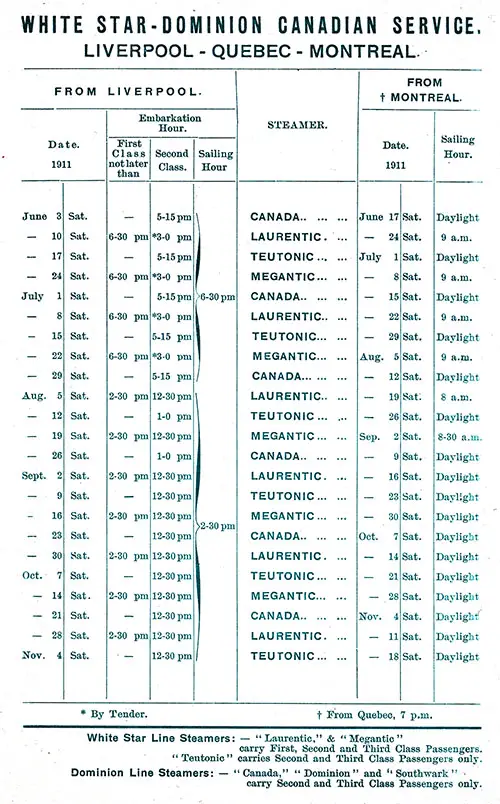
Sailing Schedule, Liverpool-Quebec-Montreal, from 3 June 1911 to 18 November 1911. Ships Included the Canada, Laurentic, Meganitic, and Teutonic. SS Canopic First Class Passenger List, 23 July 1911. | GGA Image ID # 211fd34469
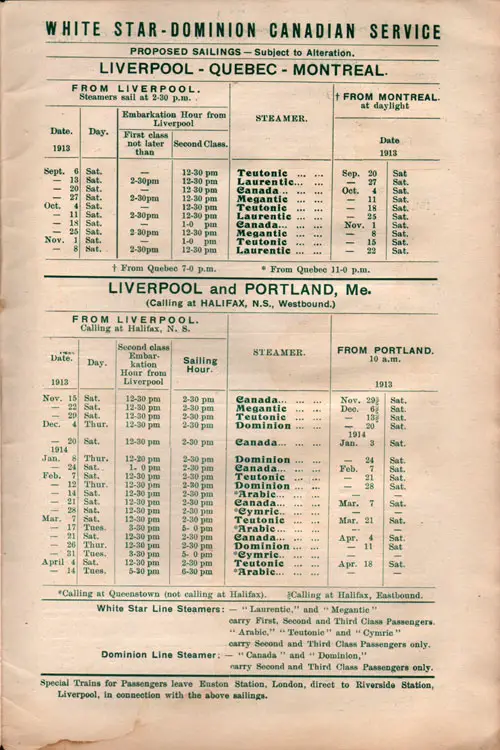
Sailing Schedule, Liverpool-Quebec-Montreal and Liverpool-Portland, ME, from 6 September 1913 to 18 April 1914. Ships Included the Arabic, Canada, Cymric, Dominion, Laurentic, Megantic, and Teutonic. SS Cretic Passenger List, 22 November 1913. | GGA Image ID # 1e57a61bc5
Return to Content Links
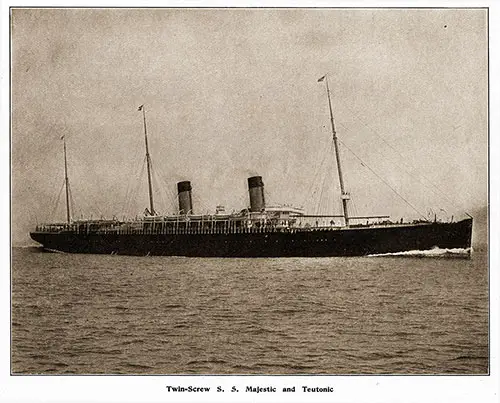
The Twin-Screw Sister Ships SS Majestic (1890) and SS Teutonic (1889). Steamers of the White Star Line, 1909. From the Chris Crofts Collection. | GGA Image ID # 210fccd10d
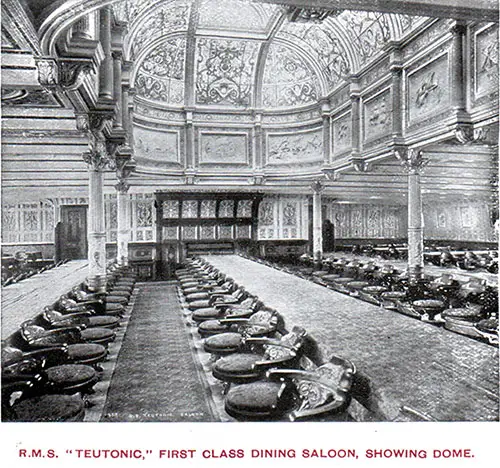
First Class Dining Saloon on the RMS Teutonic Showing Dome. | GGA Image ID # 123b542949
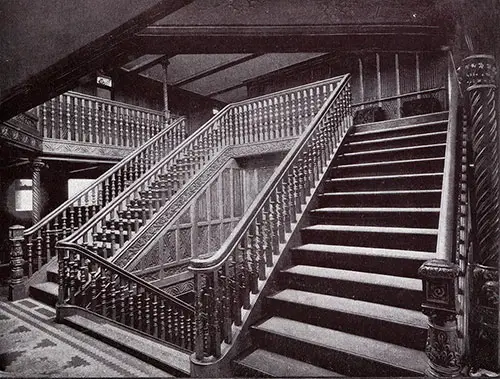
RMS Teutonic Grand Staircase. Ocean -- Magazine of Travel, September 1889. | GGA Image ID # 1ed059bd8e
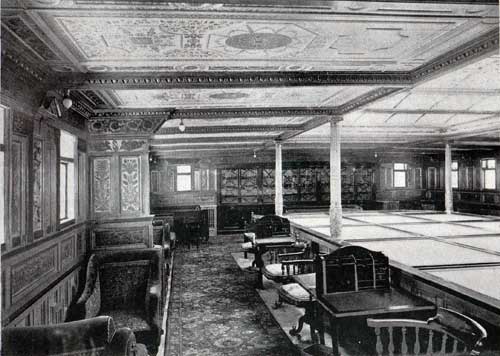
RMS Teutonic First Class Library. Ocean -- Magazine of Travel, September 1889. | GGA Image ID # 1ecf286db6
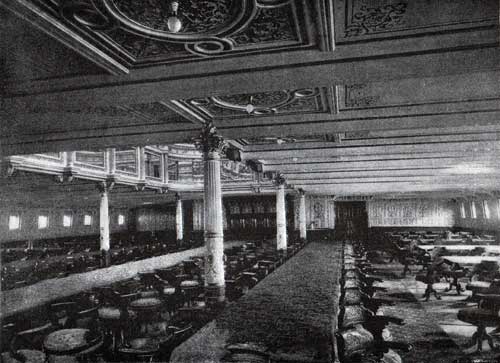
RMS Teutonic Main First Class Dining Room. Ocean -- Magazine of Travel, September 1889. | GGA Image ID # 1ecf8a6c74
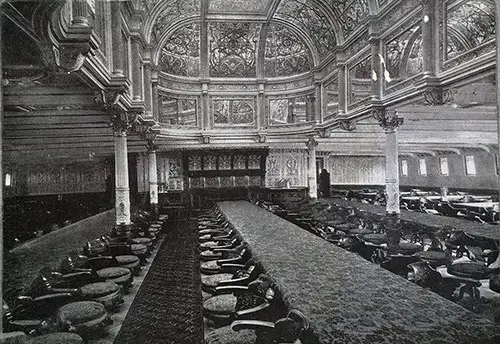
Another View of the RMS Teutonic Main First Class Dining Saloon Showing Dome Area. Ocean -- Magazine of Travel, September 1889. | GGA Image ID # 1ecf9f5784
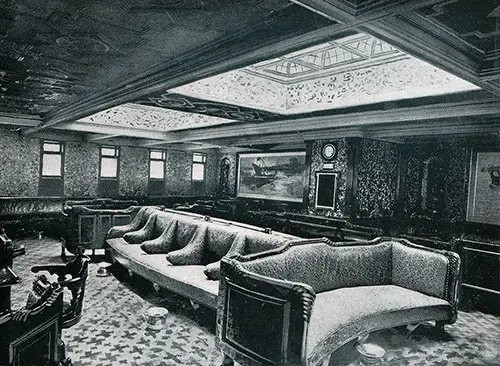
RMS Teutonic First Class Smoking Saloon. Ocean -- Magazine of Travel, September 1889. | GGA Image ID # 1ecffe7b42
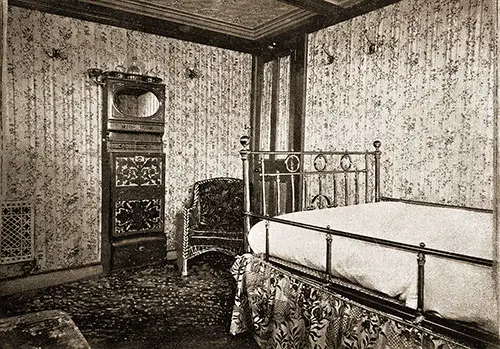
RMS Teutonic First Class Stateroom. Ocean -- Magazine of Travel, September 1889. | GGA Image ID # 1ed03a9175
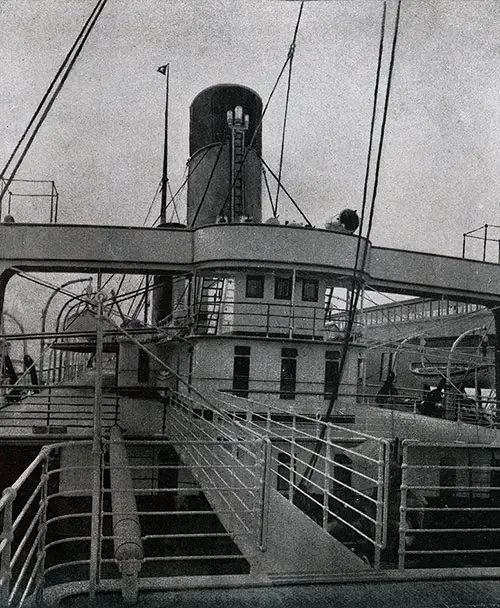
Promenade Deck of the RMS Teutonic. Ocean -- Magazine of Travel, September 1889. | GGA Image ID # 1ed355d8cd
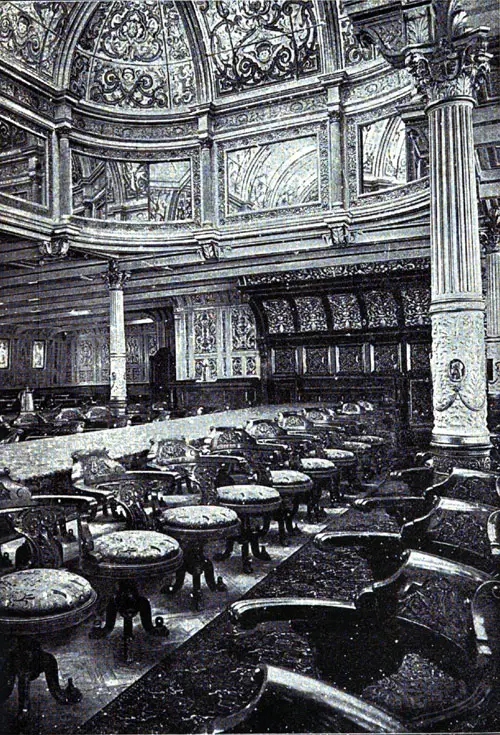
Under the Dome in the First Class Dining Saloon, RMS Teutonic. Our Ocean Reailways, 1893. | GGA Image ID # 1ed1421b78
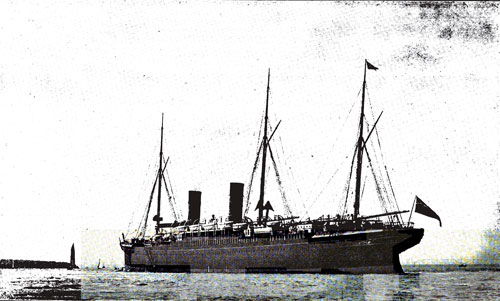
The RMS Teutonic Off Spithead. Our Ocean Railways, 1893. | GGA Image ID # 1ed182e1da
Return to Content Links
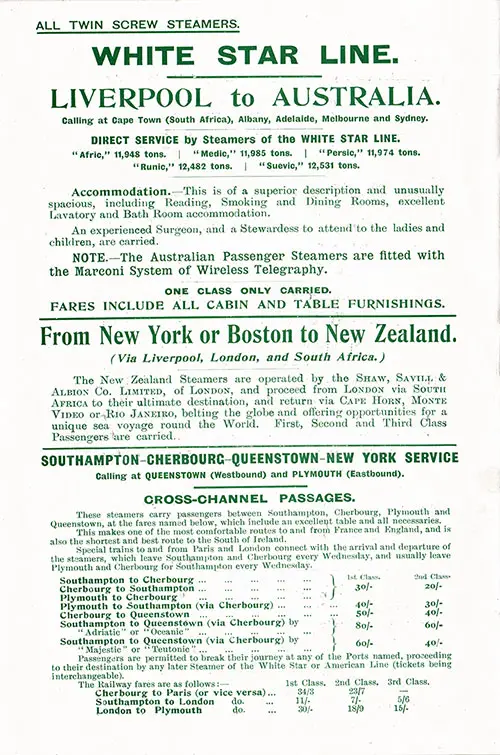
White Star Line Services: Liverpool to Australia, New York or Boston to New Zealand, Southampton-Cherbourg-Queenstown-New York Services, and Cross-Channel Passages and Fares. Ships Included the Afric, Medic, Persic, Runic, and Suevic. RMS Teutonic Passenger List, 14 September 1910. | GGA Image ID # 1ed1b0b768
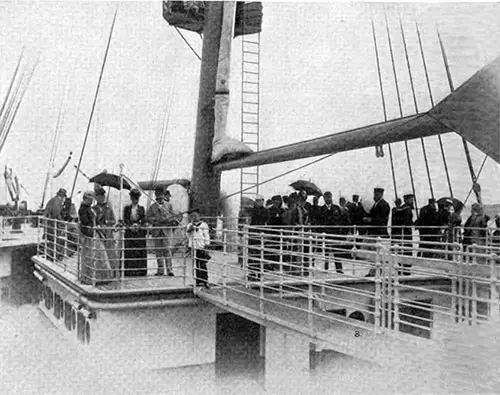
Passengers On the Promenade Deck of the RMS Teutonic. The Great Atlantic Liners, May 1895. | GGA Image ID # 1ed2e22390
Return to Content Links
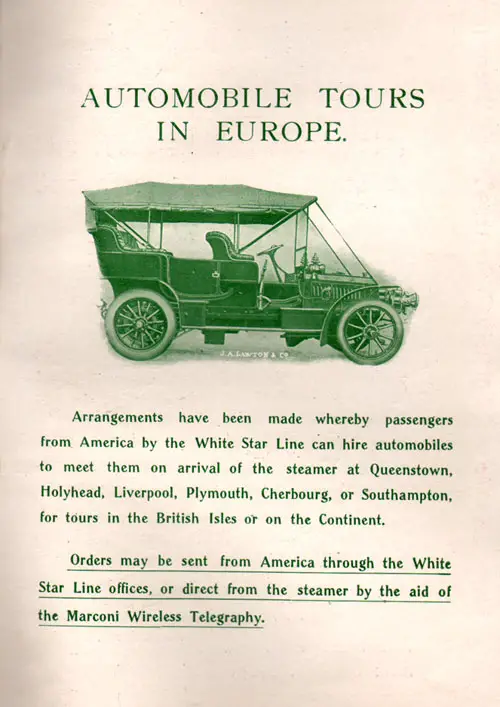
Advertisement: Automobile Tours in Europe, 1910. Arrangements Have Been Made Whereby Passengers from America by the White Star Line Can Hire Automobiles to Meet Them on Arrival of the Steamer at Queenstown, Holyhead, Liverpool, Plymouth, Cherbourg, or Southampton, for Tours in the British Isles or on the Continent. RMS Teutonic Passenger List, 14 September 1910. | GGA Image ID # 1ed268daad
Return to Content Links
Information for Passengers, May 1898
- Breakfast from 8:30 until 10:00 am
- Luncheon at 1:30 pm
- Dinner at 7:00 pm
Divine Service in the Saloon on Sunday at 10:30 am
PLEASE apply to the Second Steward for Seating Accommodation at Table.
Letters for Passengers on-board outward-bound Steamers at Queenstown, mailed on the day the Steamer sails from Liverpool, must be registered and addressed thus:
c/o The Commander,
M……….. Passenger per R.M.S.
Queenstown.
Telegrams must be addressed to care of "Ismay. Queenstown," otherwise a charge of 5/- extra is made if addressed to the steamer direct.
Cablegrams and Telegrams should be handed to the Saloon Steward an hour before arrival at Queenstown.
The Saloon Steward will supply Stamps, Telegraph Forms, Books of Reference, and Railway Timetables of the principal Companies.
Questions relating to Baggage should be referred to the Second Steward, who is the Ship's Baggage Master; Trunks, Chairs, or Rugs which Passengers may desire to leave in charge of the Company, should be properly labelled and handed to the Second Steward.
Deck Chairs can be hired at a charge of 4/- each for the voyage, 24 hours' notice being necessary in London, or 12 hours at the Head Office, Liverpool.
The Company will not be responsible for Valuables or Money unless given in charge of the Purser, who will give a receipt for the same on the Company's Form.
Passengers are requested to ask for a Receipt on the Company's Form, for any additional Passage Money or Freight paid on board.
Saloon Passengers joining the White Star Mail Steamers at Queenstown and leave Euston, London at 8.45 pm, or Liverpool at 11.00 pm on the day of sailing; Holyhead by Mail Steamer, 2.25 a.m. Thursday; and from Amiens Street Station, Dublin, by the Special American Mail Train, 6 am, arriving at Queenstown 10.15 am Thursday.
N.B. Passengers will please note, that no dogs can be brought from American into Great Britain without a license from the Board of Agriculture.
Source: SS Teutonic Passenger List - 18 May 1898
Information for Passengers, September 1910
- Breakfast from 8 until 10 o'clock.
- Luncheon at 1:00 pm
- Dinner at 7 o'clock
The Bar opens at 8:00 am, and closes at 11:30 pm
Lights are extinguished in the Saloon at 11:00 pm: Lounge at 11:30 pm, and Smoking Room at 12 Midnight.
Divine Service in the Saloon on Sunday at 10:30 am
Seats at Table. Passengers who have not previously arranged for seats at table to be reserved should apply for same to the Second Steward.
Children are not entitled to seats in the Saloon unless full fare is paid.
Wireless Telegrams. All Southampton — Cherbourg — Queenstown — New York, Liverpool- Queenstown—New York, Liverpool--Quebec—Montreal, and LiverpoolQueenstown—Boston Mail and Passenger Steamers of the White Star Line are fitted with the Marconi system of Wireless Telegraphy, and messages for despatch should be -handed to the Purser.
The Surgeon is authorized to make customary charges, subject in each Case to the approval of the Commander, for treating Passengers at their request for any illness not originating on board the ship. In the case of sickness developed on board no charge will be made, and medicine will be provided free in all circumstances.
Cablegrams and Telegrams should be handed in to the Saloon Steward an hour before the arrival at any port called at.
The Saloon and Library Stewards will supply Stamps, Telegraph Forma, Books of Reference and Railway Time Tables of the Principal Companies.
Baggage. Questions relating to Baggage should be referred to the Second Steward, who is the Ship's Baggage Master. Trunks, Chairs which Passengers may desire to leave in charge of the Company, should be appropriately labeled and handed to the Baggage Master on the Wharf at New York, and such articles will be stored entirely at owner's risk. It is necessary for Passengers themselves to see all their Baggage is passed by the U.S. Customs Authorities on landing.
Deck Chairs can be hired at a charge of 4/- each for the voyage. Steamer Rugs can be hired at a charge of 4/- each for the voyage.
Passengers are requested to ask for a Receipt on the Company's Form, for any additional Passage Money, Chair or Steamer Rug Hire, or Freight paid on board.
The Purser is prepared, for the convenience of Passengers, to exchange a limited amount of English and American money, and he will allow at the rate of $4-80 to the £1 when giving American money for English currency, or £1 for $4•95 when giving English money for American money.
The following additional rates of exchange have also been adopted for American and French money—Eastbound $1 = 5 francs; Westbound 1 fr. = 19 cents,
Should the Steamer arrive at the New York Wharf after 8:00 pm, Passengers may land if they wish to do so, and have their baggage passed by the Customs authorities immediately on arrival, but those who prefer to remain on board may do so, and have the whole of their baggage passed the following morning not earlier than 7 o'clock.
Breakfast will be served to those who remain on board over night.
Passengers' Addresses may be left with the Saloon Steward, in order that any letters sent to the care of the Company may be forwarded.
Valuables. The White Star Line has provided a safe in the office of the Purser, in which Passengers may deposit money, jewels, or ornaments, for safe keeping. The Company will not be liable to Passengers for the loss of money, jewels or ornaments by theft or otherwise, not so deposited.
Travellers' Cheques, payable in all parts of Europe, can be purchased at all the principal offices of the White Star Line. These Cheques are accepted on board White Star steamers in payment of accounts, but the Pursers do not carry funds to enable them to cash same.
Automobile Tours. Arrangements have been made whereby Passengers by the White Star Line can hire automobiles to meet them on arrival of the steamer at Queenstown, Holyhead, Liverpool, Plymouth, Cherbourg or Southampton for tours in the British Isles or on the Continent. Orders may be sent from America or Canada through the White Star Line Offices, or direct from the steamer by the aid of the Marconi Wireless Telegraph.
Dogs. Passengers are notified that dogs cannot be landed in Great Britain unless a license has previously been procured from the Board of Agriculture, London. Forms of license must be obtained by direct application to the Department before the dog is taken on board.
This Steamer is fitted with Marconi's system of Wireless Telegraphy and also with Submarine Signalling Apparatus.
Wireless Telegram Rates.
United States.—The minimum Marconi rate via Seagate, Segaponack or South Wellfleet (Cape Cod), or through the medium of a passing steamer and one of these stations is 8s. 4d. for ten words. Each extra word 6d.; text only counted; address and signature free; land charges additional all fees must be prepaid.
The minimum rate via Siasconsett or Cape Race, or through the medium of a passing steamer and these stations is 12s. 6d. for ten words. Each extra word 9d.; text only counted; address and signature free; land charges additional; all fees must be prepaid.
The minimum Marconi rate via Sable Island, or through the medium of a passing steamer and this station is 168. 8d. for ten words. Each extra word is.; text only counted; address and signature free; land charges additional; all fees must be prepaid.
Canada.—The minimum Marconi rate via Quebec, Grosse Isle and Father Point, or through the medium of a passing steamer and one of these stations is 1s. ld for ten words; each additional word lid. The minimum Marconi rate via Clarke City, Fame Point, Heath Point, Whittle Rocks, Point Rich, Point Amour, Belle Isle, Cape Ray, or through the medium of a passing steamer and one of these stations is 45. 2d. for ten words; each extra word 3d. The minimum rate through the Cape Race station, or through the medium of a passing steamer and this station is ids. 6d. for ten words; each extra word 9d; text only counted; address and signature free; landline charges additional. All charges must be prepaid.
United Kingdom.—The rate via Crookhaven or other stations in the United Kingdom, or through the medium of a passing steamer, is ltd. per word; every word in address, text, and signature counted; land charges additional; all fees must be prepaid.
Ship To Ship The rate from ship to ship is 8d. per word; every word in address text and signature counted, and all fees must be prepaid.
Steamer Rugs Can be hired on application to the Purser at a charge of 4/- each for the voyage.
Landing Arrangements at New York
Should the Steamer arrive at the New York Wharf after 8:00 pm, Passengers may land if they wish to do so and have their baggage passed by the Customs authorities immediately on arrival, but those who prefer to remain on board may do so, and have the whole of their baggage passed the following morning not earlier than 7 o'clock. Breakfast will be served to those who remain on board overnight.
Special Notice.
The attention of the Managers has been called to the fact that certain persons, believed to be Professional Gamblers, are in the habit of traveling to and fro in Atlantic Steamships.
In bringing this to the knowledge of Travellers the Managers, whilst not wishing in the slightest degree to interfere with the freedom of action of Patrons of the White Star Line, desire to invite their assistance in discouraging Games of Chance, as being likely to afford these individuals special opportunities for taking unfair advantage of others.
Source: RMS Teutonic Passenger List - 14 September 1910
Return to Content Links
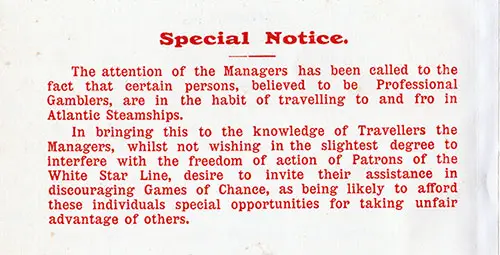
Special Notice Concerning Professional Gamblers Traveling on Transatlantic Steamships, 1910. RMS Teutonic Passenger List, 14 September 1910. | GGA Image ID # 1ed2972983
Return to Content Links

A Century of Sea Travel: Personal Accounts from the Steamship Era
This book is a voyage through the life of the passenger steamship, a voyage described by travellers who sailed on these vessels, and it carries within it their thoughts and experiences, mirrored here in words and pictures.

Christie's Ocean Liner Auction Catalog - 2007
The Christie's Ocean Liner Auction Catalog 2007 included Posters, Ship Models, and Decorative Arts. The provenance of the Items was sourced from The Estate of Wayne LaPoe, The Kenneth C. Schultz Collection, The Jan J. Loeff Collection, The Marcello Collection, and The Collection of Terrence G. O'Connor.
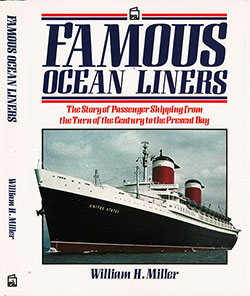
Here is the story of twentieth-century passenger shipping, from the first of the superliners — the German Kaiser Wilhelm der Grosse — to Cunard's Queen Elizabeth and Queen Mary, right up to Queen Elizabeth 2.

Great Passenger Ships of the World 1858-1912
This initial volume deals with Ships from 1858-1912, from the first passenger ship of over 10,000 GRT to be placed in service (the Great Eastern) to those unforgettable sister ships, the Olympic and Titanic — the first of more than 40,000 GRT.

Legacy of the White Star Line: History of the Titanic, Her Sisters, and Other White Star Liners
The Titanic disaster has fascinated the world since she sank, losing over 1,500 lives in April 1912. This copiously illustrated book considers much more than its title suggests, beginning with an overview of the White Star Line's fleet.

Liverpool and the Mersey, Vol. 1: Gladstone Dock and the Great Liners
More than 190 rare archive photographs and maps, many never before published, recount the story of this most famous dock and the Great passenger Ships that were once a regular sight there.

Lost Liners, Titanic to the Andrea Doria
Maps, charts, and diagrams make this handsome volume a valuable reference tool and a compelling evocation of that glorious era when floating palaces ruled the sea lanes.

Majesty at Sea: The Four Stackers
The opulent and luxurious four-funnel passenger liners, of which only fourteen have ever been built, are unsurpassed in maritime history. Built between 1897 and 1921, these great vessels vied with each other in their standards of comfort, spaciousness, and speed, and great was the rivalry between their owners.

White Star Line - Merchant Fleets # 19
Despite the misfortunes of the White Star Line, it is still regarded with esteem and affection. For those born after the end of White Star, this vol. is, therefore, deliberately comprehensive and definitive. There is the usual chronological company history. Seventy-four scale profile drawings illustrate each of the 98 ships. The career history of each ship is given.

Ocean Liners - Precursors, Apotheosis, Post War
Ocean Liners is a detailed look at nearly fifty fabulous ships that have provided pleasure, practicality, and fascination since the beginning of the century.

Ocean Steamers: A History of Ocean-Going Passenger Steamships 1820-1970
A history of the steam-powered passenger ship that details its story from the SS Savannah of 1819 to the SS Hamburg of 1969. It contains historical details of all civilian vessels built in the intervening years, with numerous illustrations and previously unpublished material.
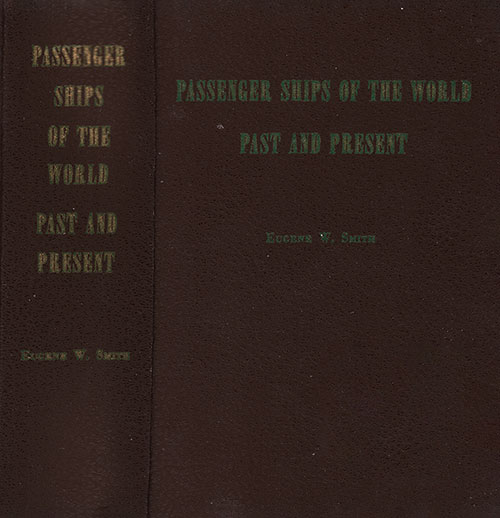
Passenger Ships of the World - 1963
🎓 “A Global Voyage Through Steamship History for Historians, Genealogists, and Maritime Enthusiasts”
Eugene W. Smith’s Passenger Ships of the World – Past and Present (1963) is a masterfully curated encyclopedic reference that charts the rise, peak, and transformation of ocean-going passenger ships through nearly two centuries. Expanding upon his earlier Trans-Atlantic and Trans-Pacific works, Smith offers a global maritime panorama that includes ships serving the Americas, Africa, Europe, Asia, Australia, and Oceania, as well as Canal routes and California-Hawaii shuttle lines.
🧭 This book is an essential resource for:
- Maritime historians seeking design evolution and fleet data
- Genealogists tracing voyages and shipping lines
- Educators and students studying transoceanic migration and tourism
- Ship modelers, naval architects, and enthusiasts interested in dimensions, tonnage, and speed

Sailing Seven Seas: History of the Canadian Pacific Line
With a witty and informative style, author Peter Pigott evokes-not only the nostalgic heyday of ocean travel but reveals a slice of almost-forgotten Canadiana.

Sway of the Grand Saloon: A Social History of the North Atlantic
History of the ocean liners of the North Atlantic crossings. A comprehensive history of Trans-Atlantic passenger ships covering 1818 - 1968, with 55 b/w illustrations, photos, and drawings.
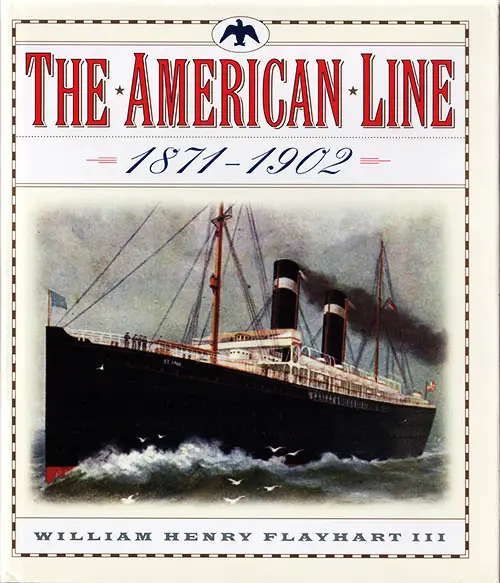
The American Line: 1871-1902 (2000)
📚 "Restoring the Stars and Stripes to the North Atlantic"
William H. Flayhart III’s The American Line: 1871–1902 is a powerful narrative chronicling one of the most ambitious yet underappreciated efforts in U.S. maritime history: the rebirth of American transatlantic shipping in the age of steam. For teachers, students, historians, genealogists, and lovers of ocean liner history, this book offers an indispensable resource on how the American Merchant Marine tried to reclaim its former glory after the Civil War devastated the industry.
The book centers around the rise of the American Line, backed by Philadelphia’s business elite and the Pennsylvania Railroad, and its close cousin, the Red Star Line, launched under a foreign flag to circumvent U.S. restrictions. Flayhart’s exhaustive research delivers a sweeping yet accessible account of how these two lines changed the face of transatlantic travel.

The Blue Riband of the Atlantic
The blue riband of the Atlantic was the symbolic prize awarded to the luxury liner that made the fastest crossing of the Atlantic Ocean. This book begins with a description of the origins of ocean steamship travel and then discusses the development and careers of the most famous ships involved.

Tourist Third Cabin: Steamship Travel in the Interwar Years
Ocean Liners and New Vistas of Interwar Society From Immigrants to Tourists. The Changing Complexion of Translatlantic Passengers as The Soul of a Ship. Experience and Life of Below-Deck Personnel Traveling Palace or Floating Sweatshop. The Experience of Women Seafarers Projecting an Image: The Allure of MTransatlantic Travel.
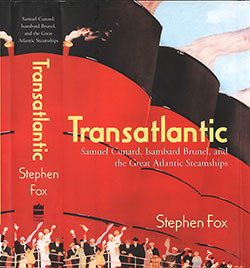
Transatlantic and the Great Atlantic Steamships
A stirring narrative of the rapid development of the great transatlantic steamships, from paddle-wheelers to the sleek luxury greyhounds of the modern era -- and the men who designed and ran them.
Return to Content Links
The well-known prestige of the White Star Line has been greatly enhanced by the latest addition to their fleet of the "ocean flyer" Teutonic, fully illustrated in the present number.
The distinguished and honored CAPTAIN HENRY PARSELL, R. N. R., is her commander. He is a man of 56 years, having been born in 1833, in the town of Sunderland, Durham County, England, which place he must have left at a very tender age, as he received his early education at a college in Wales, and set out, when a mere stripling of fourteen, upon his career as a seaman.
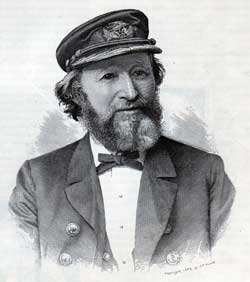
Captain Heny Parsell, R. N. R.
His first experience being on a sailing vessel of 500 tons, trading between London and the East. After a varied and useful career of about twenty-three years, he entered, in 187o, the service of the favorite White Star Line, as second officer of the steamship Oceanic, the pioneer vessel of the line; being subsequently promoted to chief officer of the same ship; and; in due course, with speedy promotion, becoming captain of the Tropic, Gaelic, Oceanic, Adriatic, Coptic, Ionic, Britannic, and Teutonic, respectively
Prior to the maiden trip of the last-named noble vessel, he received an honorary commission of lieutenant in the British Navy, and therefore hoists the blue ensign on whatever vessel he commands.
As far as incidents are concerned, his career has been most uneventful, being singularly fortunate in having avoided accidents, shipwrecks, or disasters of any kind, which in a great measure accounts for the confidence in which he is held not only by the company and the patrons of the line, but by ocean travelers in general.
He has navigated the Arctic, Antarctic, and all other seas, as well as all important rivers on this planet of ours. He is genial, patient, and painstaking in all he undertakes; has a pleasant word and smile for all he comes in contact with; is devoted to duty; is admired for his kindness; is every inch a mariner, in fact, what we might term an "ocean, veteran," and is highly esteemed by everybody as a great sailor.
THE WHITE STAR LINER "TEUTONIC."
The times have changed, and we live in an age of progression," may well exclaim the experienced traveler as he views the massive proportions of the mammoth new racer that has been added to the famous fleet known far and wide as the White Star Line. Enormous changes have taken place within the past quarter of a century in the character of steamships, and during the last decade the march of improvement in hull, machinery, and luxurious accommodations has been simply marvellous.
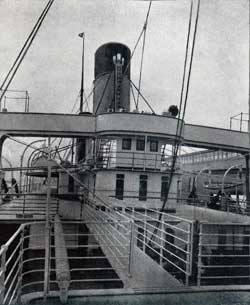
A View from the Promenade Deck of the White Star Liner Teutonic - 1889
Thirty years ago, crossing the Atlantic was an undertaking not to be lightly entertained, and was the subject of much thought, preparation and deliberation on the part of those contemplating the trip. The steamships were small, and they frequently came into port bearing the marks of severe punishment inflicted by the erratic and turbulent seas of the mighty Atlantic.
Twelve days, in moderate weather, was considered a fair passage, and at the expiration of that time the weary passenger was only too happy to escape from the not over neat, incommodious steamship. The cabin was beyond the reach of persons of moderate means, the rate was excessive, the majority of those who paid it were wealthy, or forced into the outlay by some pressing exigency.
The saloon itself was not more commodious than the smoke rooms of modern steamships, and the staterooms below the main-deck, narrow and stuffy, were as bare and comfortless as can well be imagined. Both saloon and staterooms were aft; and when the ship encountered a cross, or head sea, the passengers were pitched out of their berths in the staterooms, and unceremoniously ejected from their seats when at the dinner-table.
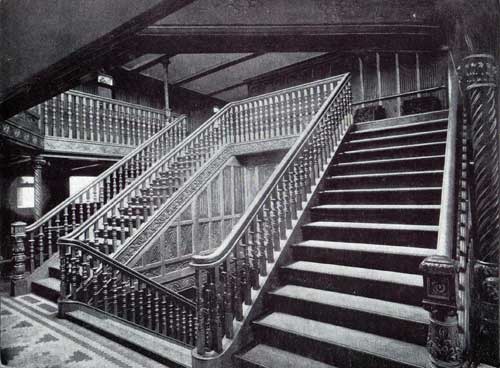
The Grand Staircase of the White Star Line SS Teutonic
Warm meals were almost an impossibility, as all the dishes had to be carried along the exposed deck from the galley, which was a long distance from the cabin. There were no softly upholstered smoking-saloons, no electric bells, no pianos, and no flowers. today the old order governing ocean travel has disappeared, and through the rapid march of modern innovations, a trip across the Atlantic is viewed as the ne plus ultra of luxurious journeying.
The change in the location of the grand saloon from the stern of the ship, where it was hemmed in by staterooms, making a long, narrow, badly-lighted and poorly-ventilated apartment, removing it from over the jar and tremble of the screw to a position amidships, somewhat forward of the center, was an innovation inaugurated by the White Star Line on the advent of their pioneer steamship in 1870.

In the Library of the White Star Line Teutonic
The feature was very popular, productive of greatly increased comfort, and has been widely adopted by other lines. When the first vessels of the line were brought to Liverpool from Belfast they created a sensation and became the subject of comment and observation. Events have proved that the builders reached a high degree of speed and safety, and that no steamships have been better able to cope with the Winter storms of the fierce Atlantic.
For twenty years, in Winter as in Summer, the steamships of the White Star Line have lived down adverse criticisms, and the best evidence of the value of the improvements introduced by this company is that they have been adopted by all rival lines.
In May, 1875, the Germanic, the latest addition to the White Star Atlantic fleet, was placed on the New York and Liverpool route, and with her sister ships completed the famous and splendidly equipped fleet of liners that soon won the reputation for possessing superior speed, efficiency and uniformity of passages.
As an instance of the regularity attained by the line, the Britannic, in 1876, averaged for six voyages outward 7 days, 18 hours and 26 minutes, and in 1886 made her fastest passage, being then twelve years in commission. On her trip last month she made the run from Queenstown to Sandy Hook in 7 days, 11 hours and 54 minutes.
Since 1874 the White Star fleet has made no special effort to shorten the time in making the passage across the Atlantic; but the important subject was by no means lost sight of. Eight years ago Messrs. Ismay, Imrie & Co. agreed upon the model and general features of a new and advanced type of marine architecture, quietly awaiting an opportune period for their project to become an accomplished fact.
The carefully-prepared and well-matured plans for twin-screw steamships were put in the builder's hands during the Summer of 1887, and the Teutonic is the result of Messrs. Harland & Wolf 's handiwork. It is with no small sentiment of pride that the firm point to the fact that they have built fifteen steamships for the White Star Company, which enjoys the reputation of being the most efficient and best appointed service in the transatlantic trade.

In the Main Saloon of the Teutonic
The leading features of the Teutonic were briefly described in the January issue of OCEAN, since which date the racer has made her debut and steamed triumphantly into the waters of New York Harbor. Her length is 582 feet, constituting her the largest ship afloat; breadth, 57 feet 6 inches; depth, 39 feet 4 inches, with a gross tonnage of 9,686 tons.
The combined horse-power is 2,400, and is expected to develop over 17,000. The amount of coal consumed is about 235 tons per day. In form and construction of hull, the Teutonic possesses all the distinctive features of outline and strength which have made the White Star fleet famous the world over, with the addition that she is minutely sub-divided by athwartship bulkheads as well as a longitudinal bulkhead running fore and aft throughout the greater portion of her length, greatly increasing the security of the steamship in case of collision.
The lines of the Teutonic have all the preciseness and grace usually possessed by a yacht. The straight cutter stem has a very business-like air about it; while the tapering sheer, rounded counter and shapely stern presents as perfect a picture of marine architecture as any nautical expert will allow. She is built of Siemens-Martin steel, and propelled by two independent sets of triple-expansion engines, constructed by Messrs. Harland & Wolff, driving twin-propellers with manganese bronze blades.
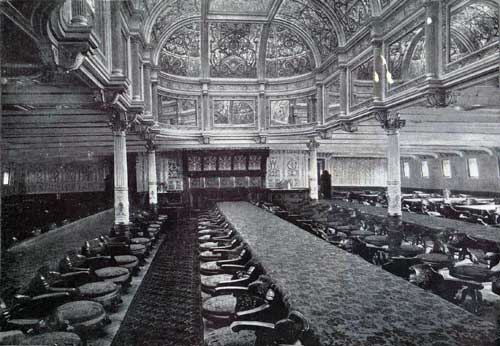
Another View of the Main Saloon of the Teutonic
Below the water-line more than usual care has been taken to diminish skin friction as much as possible, and to accomplish this the plating has been carefully cleaned, rubbed down and smoothed, then treated with a coating of Rahtnjen's celebrated composition. So nicely has this been done that the bottom plating of the Teutonic is as smooth as glass, having the appearance of an enameling process.
In the construction of the Teutonic, while every improvement that could possibly be applied with benefit has been utilized, the type and main features that have characterized the line remain intact. The single screw, which performed satisfactory work for the 5,000-ton steamship, has been swept aside in favor of the twin-screws for the 10,000-ton racer. An important feature, and one that will greatly interest professional men, is the disposition of the steering apparatus on the main-deck, where all on board who choose may view its massive proportions and ingenious workings.
There is a large cog-wheel on the rudder-head that is connected by gearing to two sets of steam-engines specially built for the purpose, by which means the huge rudder is managed as easily and readily as a yacht's. There is also a tiller, fitted with tackles, all in position, and ready for instant use should an emergency arise.
Though similar in hull and outline to the remainder of the fleet, and having two funnels, like the Britannic and Germanic, but set some sixty feet apart, the masting of the Teutonic is entirely different, and is a direct departure from the methods formerly in vogue. Three large, symmetrical pole masts, without yards, take the place of the familiar four masts possessing full sail power and cumbersome top hamper. The application of twin-screws has emphatically struck a death blow to sail power and the use of heavy spars aloft.
A striking feature of this noble steamship rests in the hurricane or promenade-deck, which is two hundred and forty-five feet long, or nearly one-twentieth of a mile, with a clear width of eighteen feet on each side of the deck-houses, and free from obstructions of every description, the boats being disposed of on an awning-deck above, which at the same time affords shelter during bad weather.
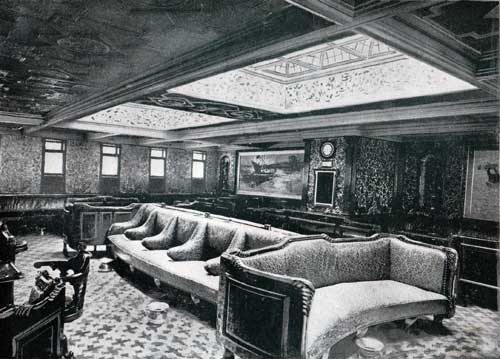
A View of the Smoking Saloon of the Teutonic
A clear space extending from 10 to 12 feet beyond the swell of the deckhouse enables passengers to promenade completely around the deck structure without break or interference of any kind, thus placing at their disposal, for the purpose of exercise and pleasure, 600 feet of space, or nearly one-eighth of a mile. This is a feature that will at once commend itself to the weary and ennuied traveler, who, braving storm and hissing squalls, prefers to remain on deck where there is plenty of room, in lieu of the closer atmosphere below.
On no other steamship afloat do the accommodations exist that are here devoted exclusively for the pleasure and use of the restless, vigorous and thoroughly-seasoned tourists. On this deck are the quarters of the commanding officer, which are unusually roomy and luxurious in character.
Every facility for communicating instantly with those intrusted with important duties are at the commander's hand; while charts, books, instruments, and all the paraphernalia of a nautical commander find place within allotted spaces. Staterooms A, B, C and D, are also located on this deck, and from their freedom from obstructions of all kinds, with an uninterrupted view of the ocean in all its moods, and with an unlimited supply of ozone and health-giving salt air they are, therefore, specially desirable.
Adjoining the main entrance on this, the promenade-deck, is the library, containing bookcases filled with a careful collection of the choicest works published. The apartment is particularly light and attractive, being paneled in light oak, the wood of which was carefully selected on account of grain, color and texture, carrying a novel ornamentation produced by burning the design in a gilt ground, varied by carvings exquisitely executed, and hand-made panels in varied colored crewels on a pale-blue satin ground.
The room is lighted at the sides by windows, covered with glass shutters of Italianesque design, that admits of a subdued and mellow light, particularly adapted for those making use of the magnificently appointed apartment. Additional light is furnished by the richly stained glass dome. Every device and appliance that could possibly add to the comfort and luxury of the inmates has been furnished. Revolving chairs that, while inviting rest and contentment, occupy but little space, are here found in conjunction with individual writing tables.
In the center of the apartment is a massive sheet of opaque glass, in the form of a table, from the edges of which rise fluted columns, carved, decorated and adorned with the highest art of the carver's handicraft. Over head, the eye is greeted with panels, large and artistically covered with intricate and quaint patterns of delicate tracery, relieved by colorings and effects that tend to deceive the eye and add entranced height to the noble proportions of the ornate library.
Seductive chairs, covered with warm and costly stuffs. stand invitingly forth from quiet nooks, while the effect of light and shadow on carvings, massive oak decorations, distant alcoves and sequestered retreats, all add indescribable charms to the delighted guest and thoughtful, quiet reader and student.
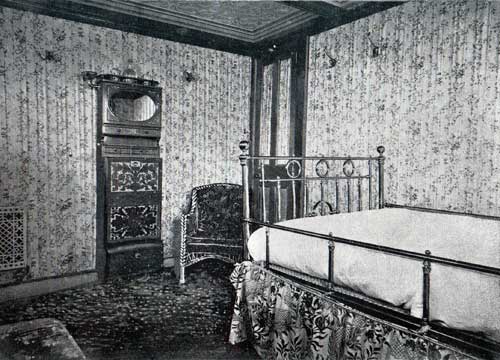
A View of a Stateroom on the White Star Line Steamer Teutonic
Passing down through the main entrance to the upper-deck the comfortable quarters of the purser is found, and we will now pause for a moment by the grand staircase, which in any steamship is a marked and prominent feature, generally reserved for an elaborate display of ornamentation and carved and polished effects.
The main staircase of the Teutonic is singularly free from all such innovations, but the effect is none the less striking and impressive. The fittings, panels and material generally is composed of selected English oak, which, as it becomes tempered and mellowed with age, assumes a darker and richer hue until it is difficult to distinguish it readily from black walnut. It is the same style of oak that for centuries has made England famous in her wainscotings in abbeys, chapels, residences, and manor-houses generally.
The stairs are wide, spacious and gradual in descent, terminating in a broad, substantial landing which is relieved by an inlaid, tinted rubber floor, that contrasts pleasingly with the shades of oak. The balustrade is highly polished, massive and relieved by a deep beading. The upright rounds are correspondingly heavy, fitting into side pieces that are hand-carved in a beautiful pattern of bas-relief. The newel posts are heavy, finely polished and handsomely carved, while supporting pillars, bearing a pattern of a circular description with the heads of tritons, complete as fine an effect as can well be imagined from a refined and artistic point of view.
On this deck, forward of the grand staircase, are some of the choicest staterooms in the ship, furnished with baths and every possible convenience. They are unusually large, with handsome brass bedsteads. They are lighted with windows, which open onto the promenade around the deckhouse, giving fresh air in abundance; they are also connected by electric bells with the necessary departments of this great floating city. Nothing finer or more complete in every detail has ever been placed at the disposal of the public.
In addition to the rooms already mentioned, on this deck, further aft, is the gentlemen's lavatory, the barber's shop, and the finely-appointed smoking-saloon. This apartment, as one of the attractive features of the great racer, deserves more than passing attention. Here may be found the ne plus ultra of a smoker's paradise, the acme of human comfort and pure contentment. Nothing that approaches a straight back chair or disagreeably formed sofa has been allowed place within the generous bounds devoted to the devotees of the fragrant weed. As Byron has it :
"Divine in hookahs, glorious is a pipe. When tipped with amber, mellow, rich and ripe; Like other charmers, wooing the caress. More dazzling when daring in full dress; Yet thy true lovers more admire by far. Thy naked beauties—give me a cigar."
The walls of this room are covered with richly-gilt embossed leather, the design being a careful reproduction of one of the best patterns of the old Flemish " cuir repousse." Panels in the sides of the room are decorated with oil paintings, representing shipping from some of its most picturesque and interesting aspects.
Ships of war, old and new, dating from the gaily decorated Venetian Republic and other great naval powers of the Mediterranean in the Middle Ages. — represents the Spanish American Empire, a royal treasure ship in the 17th century, by E. J. Taylor; 2—Armed Genoese Galley in the Harbor of Venice, 16th century, by Frank Murray; 3—Columbus in Sight of America, representing the Nina, Pinta, and Santa Maria, in October, 1497, by Frank Murray; 4—The Romans in Britain during the 2nd Century, by E. J. Taylor; 5—Viking Ships in the Nile during the loth Century, by Frank Murray.
Other spaces are filled with shallow niches, each containing a figure in high relief carved in pear-wood, after Donatello. The dome and ceiling are works of art in themselves, the latter containing an old English plaster pattern in oddly-shaped panels, with finely modeled rosettes at intervals. Shutters of stained and ornamented glass fit each window, and are placed in position as soon as the electric lights are called into requisition, completely obscuring the inmates from all outside observation.
Even the floor of this apartment, like the vestibule at the foot of the grand staircase, is a novelty and a decided innovation on anything of the kind that has heretofore been introduced. It is composed of rubber, artistically colored and arranged in pleasing designs and patterns. The superior features of this over a wood floor, or one covered with oilcloth, linoleum or even the finest carpet, is obvious, as to slip on a rubber floor, when the ship pitches or rolls, is simply impossible.
The furniture and upholstering of this luxurious apartment has been carefully designed, with every attention devoted to ease and pure enjoyment. The sofas, chairs, tete-a-tetes, and accessories generally in point of costly elaborateness correspond with the fittings of the smoking saloon.

RMS Teutonic First Class Dining Saloon Showing Dome. | GGA Image ID # 1446b1566a
The grand dining-room, or main saloon, is on the main-deck, placed amidships, where there is the minimum of movement, and apart from its great size presents many unique and novel features. In general the decoration is of the Renaissance period, the tints being a subdued ivory and geld.
The walls are exquisitely enameled, relieved by a delicate and elaborate tracing, slightly shaded with a filling of gold, while the panels in this labyrinth of artistic design, executed in a glyptic material, exhibits tritons, sea nymphs, and ocean symbols generally, all gracefully grouped and executed.
The figures in relief are finished in an ivory-like surface, and the groundwork of the panels are in gold. The ports are lined with repoussee brasswork of the same Renaissance character as the walls, and are fitted with stained-glass shutters, emblazoned with the arms of the different States and cities of America, Canada and Europe, behind which are placed electric lights, so that the brightness of the design is apparent by night or day.
The ceiling, like the walls, corresponds in regard to the tints of ivory and gold, the electric lights peeping forth from numerous niches and artistic corners; the whole producing an effect almost beyond the power of language to describe. Tables of polished wood extend the entire length of the saloon, flanked on either side by revolving chairs that are upholstered in the finest plush.
The accommodations are such that three hundred passengers can be seated at one time, and as the Teutonic is not intended to carry more in the first-class quarters, the inconvenience and vexatious delays occasioned by dining in relays will be avoided. This feature will undoubtedly commend itself to the patrons of the line.
Although she is much larger than the Etruria and Umbria, still she carries only about half the number of saloon passengers, the limit having been placed at three hundred, and there is abundance of room for all this number to dine at one time in the saloon, which is 6o feet long by 58 feet wide. The rule limiting the number of saloon passengers is a good one, as it obviates the necessity of serving double meals. The great aim of the company is to furnish incomparably the finest cuisine, and served in a luxurious manner.
Surmounting this richly-appointed saloon, which, without doubt, is the most elaborate and artistic creation that is afloat, is a dome of stained glass, combining the soft and beautiful tints of the rainbow, which sparkles and flashes in the warm sunlight, or gleams in the brilliant rays of the electric light, shedding a flood of ever-changing scintillating colors over the vast area of the main saloon.
The effect is heightened by an arrangement of mirrors which reflect and multiply the gorgeous colorings, that, when in full play, with the steamship gently rolling, resembles the brilliant combinations of a mass of jewels. The carvings and effect generally surrounding the dome ace of the richest character, dazzling the eye in attempting to follow the sinuous windings of the perplexing pattern, the creation of a genius and an artist of great ability.
Forward of the grand saloon, and directly below it, on the main deck, are the regular staterooms, handsomely decorated, furnished and provided with every comfort and luxury that good judgment and discernment could suggest. A large proportion of these are two-berthed only, and so arranged that there will not be both upper and lower berth in same room. Numerous rooms of large size for families are provided, as well as rooms suitable for a single passenger.
The stateroom curtains are of art muslin, which produce a particularly fine effect. All the woodwork in the passages and hallways are beautifully modeled in artistic designs, showing on the part of the builders the greatest care, even to the minutest detail. In short, so far as the interior of the Teutonic is concerned, nothing has been left undone that good judgment and a lavish expenditure of .money could produce.
When domiciled in one of the Teutonic's spacious staterooms, seated in a luxuriously-upholstered easy chair, with finely-polished brass bedstead occupying one part of the room, the electric light revealing the richly chaste design of the tapestry covering the walls and the artistic folds of the art muslin draperies—it would be hard to realize that one was really afloat.
In point of size, the rooms are superior to those generally allotted to transient customers at the average hotel. In some of the larger staterooms on the upper-deck the fluted tapestry draping is varied with an oak paneling, relieved with gold, which is both soft and pleasing to the eye, and rich and appropriate in design. While dwelling upon the comfort and elegance of the Teutonic's sleeping accommodations, mention should be made of some of the staterooms which are fitted with bedrooms and sitting-rooms en suite.
Adjoining the grand saloon are elaborate bath and toilet arrangements, which the guests of the steamship will appreciate on account of their generous proportions and perfect ventilation. Abaft the saloon, on one side, is located a large pantry, galley, baker's shop, bread-room and butcher's quarters, with a huge receptacle for ice directly below. On the other side are staterooms leading aft, where the accommodations for the second-class passengers are located.
The second-class department is a distinctive feature of the great ship, and provides for the comfortable accommodation of one hundred and fifty passengers. There is included a roomy, finely-equipped dining saloon on the upper-deck, with a smoking and lounging-room on the promenade-deck above. All the fittings are handsome and substantial, corresponding in point of appearance with the general fittings met with throughout the steamship.
The staterooms compare favorably with the first-class accommodations generally met with on passenger ships of to-day, and are fitted with every comfort usually found in a first-class hotel. A promenade-deck is devoted exclusively to the use of those desiring a less expensive trip across the Atlantic, with bath-rooms, lavatories, and many comforts that will not fail to win the approbation of those patronizing the line.
While the arrangements for steerage passengers have always been a special feature in the White Star steamships, the Teutonic is, in many respects, a decided improvement on the older ships. The complete isolation of the single men and women at each end of the ship, and of the married people in their own quarters, in two and four-berth rooms, separate entrances, closets and locations for each division, a bath for the women and children, and a smoke-room for the men; and the comfortable steerage pantry enabling a constant supply of hot water and other comforts, is maintained for those who need them. In common with all other parts of the ship, the steerage is lighted by electricity throughout. There are accommodations, without pushing or incommoding one another, for about 750 passengers in this thoroughly-equipped department.
In building the Teutonic and Majestic, the White Star Company agreed that the vessels should be of such type and speed as would render them specially suitable for service as armed cruisers, and in accordance with plans and specifications approved by the admiralty. In consideration, the admiralty agree to pay to the company for these vessels an annual subvention, payable half-yearly, at the rate of fifteen shillings per gross registered ton per annum, such subvention to commence from the date on which the vessels, respectively, start on their first voyage with the mails.
The guns designed for these Royal Naval Reserve cruisers are of the type known as the thirty-six pounder Armstrong's, of which but four have as yet passed into the possession of the Government, and were mounted on the Teutonic when she participated 1n the late naval demonstration at Spithead. When fully equipped as a cruiser she will carry, in battery, twelve Armstrongs. At present, she has fittings to accommodate one gun on each bow and one on each quarter.
With the keen eye of an expert and the zest of one whose heart was in the work, Emperor William, when inspecting the Teutonic, at once recognized the racer's guns as something new and novel. Walking to the starboard forward gun, he accosted the detail, who had been sent from the steel-armored cruiser Howe, as to the working of the breech mechanism. He personally elevated and depressed the piece, glancing along the sights, and turning to his brother, said : " We have nothing like them; but we must have them, and at once."
Before the Emperor left, the gun detail tried the breech-loader with a blank cartridge for the special benefit of the distinguished guest, who expressed himself as highly pleased with the Teutonic in all her departments, and during the ceremonies no vessel exceeded her in point of interest with the multitudes present.
Following are the daily runs made by the Teutonic from Roche's Point to Sandy Hook Lightship on her maiden trip : August 9th, 349 knots; August 10th, 404 knots; August it th, 430 knots; August 12th, 431 knots; August 13th, 440 knots; August 14th, 454 knots; August 15th, 227 knots.
Her corrected time from Roche's Point, Queenstown, to Sandy Hook, was 6 days, 14 hours and 45 minutes.
Ocean: Magazine of Travel, Vol. III, No. 2, September 1889, Pages 34-38+
THE "TEUTONIC."
Had not the late violent gale which has swept our coast interfered with the movements of incoming steamers, it is more than probable that the Teutonic might have materially changed the champion record. But it is not too late yet. In the teeth of a North-east hurricane, which in point of fierceness has not been surpassed for over twenty years, both of the celebrated racers, Teutonic and City of New York, succeeded in lowering the records they had previously made. The Teutonic's time from Queenstown to Sandy Hook was 6 days, 7 hours and 14 minutes, which beats her own record by 7 hours and 31 minutes.
Ocean: Magazine of Travel, Vol. III, No. 2, September 1889, Page 41
Return to Content Links

